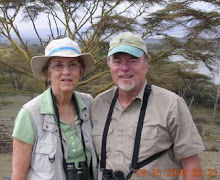





While we were at Maasi Mara our guide took us to visit a Maasi village. The Maasi tribe has rights to all of the land in the area of the national park and beyond. Mara means land. Maasi means language and people.
Each village is basically the family of the chief. He may have seven wives. Each wife has a different house (wise man!). The house has two bedrooms with wall-to-wall beds made out of interwoven twigs (the springs) covered with animal skins. They were amazingly soft feeling. The house also has a room for the calves to be brought into at night to protect them from lions, etc. A small area for storage and a place to build a fire make up the rest of the house. They are built of twigs plastered with cow dung inside and out. They last about 10 years and then another village is built with new houses.
You can see from the pictures that the village is completely surrounded by a fence made of twigs. These twigs may not look strong but they are and they are full of very long briars as well. They are there to keep the wild animals out at night.
Long before we arrived at the park area we saw Maasi men herding their animals – cattle, goats and sheep. The animals signify a man’s wealth. The animals spend each day wandering in a group looking for grass to eat. They are accompanied by a man dressed in bright red. We were told by the chief’s son that the lions and other predators have learned to fear the man dressed in red. It’s also helpful to spot another man herding his animals. (By the way, the chief’s son had gone away to school to learn English and he knew it well.)
We were greeted by a group of warriors who did a dance and song for us. The dance consisted of seeing who could jump the highest. This is used in competition vying for females’ attention. I’m not sure why they bother since the chief selects his son’s wife anyway. One evening the men came to the lodge where we were eating and performed the same dance for dinner enjoyment.
The chief’s son told us that the tribe is Christian. He pointed out that for a man to be a deacon in the church, he could only have one wife. Obviously they struggle with the conflict between Biblical standards and their culture.
I could tell you more about the price one pays to become a warrior and how the females are treated but we must save some information for when we share our pictures when we get home!
From an American’s point of view, it’s hard to believe that people live like this tribe does. But most of the people we saw did not appear unhappy. They seem content with their land, their language, and their people.

No comments:
Post a Comment